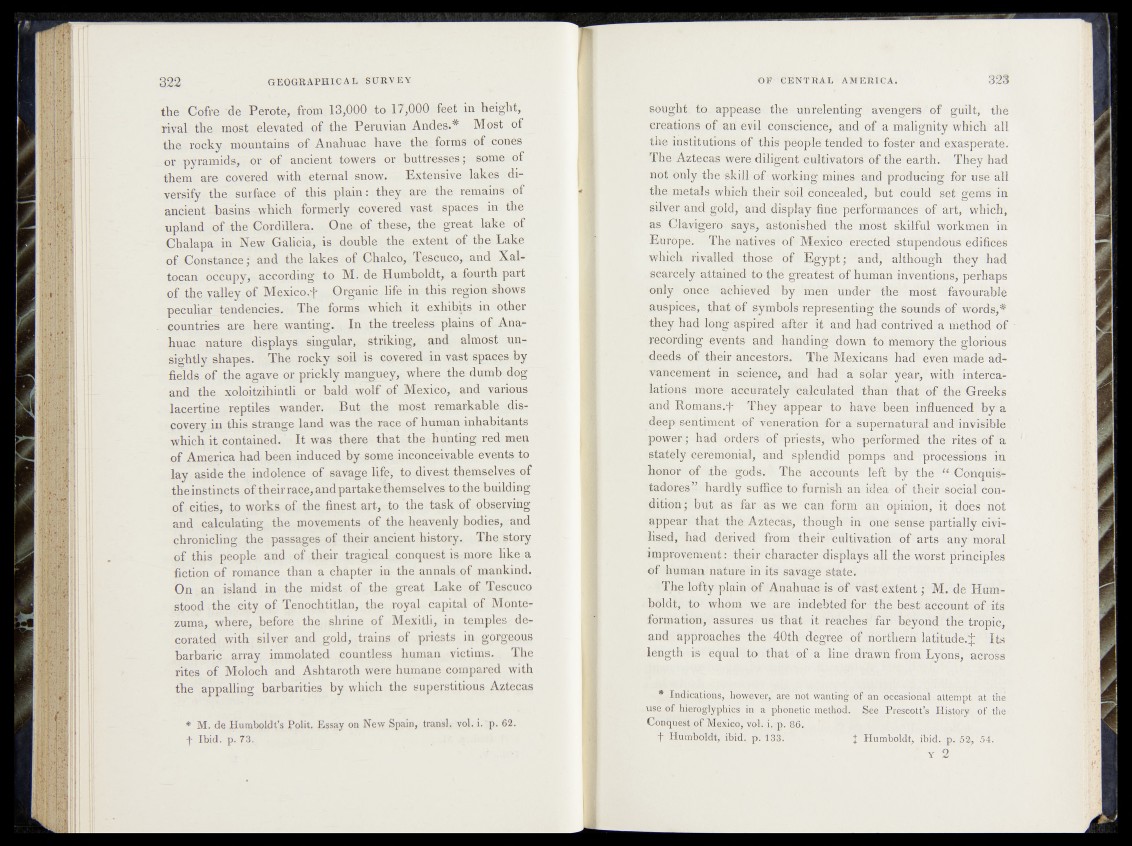
the Cofre de Perote, from: 13,000 to 17,000 feet in height,
rival the most elevated of the Peruvian Andes.* Most of
the., rocky mountains of Anahuac have the forms of cones
or pyramids, or of ancient towers or buttresses; some of
them are covered with eternal snow. Extensive lakes diversify
the surface of this plain: they are the: remainstvof
ancient basins - which formerly covered ja st,; spaces in the
upland of the Cordillera. One of these, the great lake of
Chalapa in New Galicia, is. doublethe .extentpf the Lake
of Constance* and the lakes of Chaleo, Tescuco, and Xal-
tocan occupy, according to M. de Humboldt, a fourth part
of the valley of Mexjco.f Organieflife in this region shows
peculiar tendencies. The forms which it exhibits in other
countries are here wanting. In the. treeless plains, of Ana-r
huac nature displays singular, striking, and almost unsightly
shapes. The rocky soil is covered in vast spaces by
fields of the agave or prickly manguey> where the; dumb dog
and the xoloitzihintli or bald wolf of Mexico, and various
lacertine reptiles wander. But the most remarkable ^discovery.
in this strange land was the race of human inhabitants
which it contained.' It was there that thehunriqg/red men
pf America had been induced by some inconceivable events to
lay aside the, indolence of savage life, to divest themselves, of
the instincts of their race, and partake themselves to the building
of . cities, to works o f the finest art, to .‘the task of observing
and calculating the movements of the heavenly bodies, and
chronicling, the passages of their ancient history. The story
of this people and of their tragical conquest is more like a
fiction of romance than a chapter in the annalsjtjf mankind.
On „an island in the midst of the great Lake of Tescuco
stood the city qf Tenochtitlan, the royal capital of Montezuma,
where, before the shrine of Mexitli, in temples decorated
with silver and gold, trains of priests in gorgeous
barbaric array immolated countless human victims. The
rites of Moloch and Ashtaroth were humane compared with
the appalling barbarities by which the superstitious Aztecas
* M. de Humboldt’s Polit. Essay on New Spain, transi, vol. i. p. 62.
I Ibid. p. 73.,
sought tb ^p^ea%e-.. the u n relentjrtgffavepgers of guilt, thè
creations of ari‘e$Iqcbn«cienc£/’ and of a malignity which all
the institutions-of thi^ fieople fended to foster and exasperate.
The Azteeal* were;4Higent; Cultivators of the earth. They had
noipply the'skill of -working mines and producing foÿ use nil
the metals which their s o i l b u t ?d(^MÉf'sei'gëihs in
silver and gold, and display* fine ipetformanefes ;óf art, which,
as .Cdavigerö says, ■‘astoh’jsfmrit'tbé mó^t skilful workmen*' in
Europe. -The natives^of Mexiccf* erected ^stupendous edifices
which rivalled fhqse bf * Egypt ; 4 | and; * although they had
Scarcely - attained to thé grdafkstbf human ÎOTentièh ^.perhaps
only* once achieved by men undlèr ‘ the- most f$ voidable
auspices, that of symbefsfepresentfng the soundsbof-iVords,*
ihiy had long aspired after it and had- cdfitrived 'a method* èf
fêcording events and ,hahdin^ ?dôwn to,^éi|ïOJ3ÿf'Éh#§brious
deed«* of their ancestors. The; Mexicans had even made advancement
in science,, and had "edgblar; year, with intéfear
Rations more- accurately calculated than*- that -of;the Greeks
-and Ko mans, if'1' They appear ' io h âvéVbèen' iïiffüéucëd by a
deepisehtipaent (# 'veneration fbh a^upernatprdFarid invisible.
pqWei'll had orders of priest, who performfed'thh'rites of a
stately ceremonial, and splendid'- {ibihps atari procédions in
acîôorâafe^ left by th e ’^dfebfirjuistadores^'
hardly suffice to furnish an idea - of theiè’iàdSal condition
; but as far as we can? fdrm' an opinion, it -riot
appear that the: Aztecas, though in onéNsènsfe partially civilised',
had derived from their cultivation*->!©f aits - any moral
improvement: their character displays all the wbmf principled
of human nature in its savage state.
The lofty plain of Anahuac is*;of Vast 'extent ; M. de Humboldt,
to whom we are indebted’för'-'ffte hesfeaiccount of its
formation, asèuire's - us that it reâchélr far - beÿoéd1 the-tropic^
and approaches the 4Qth degree'■ .of 'nnrtkern latitude.^ Its
length is equal to line drawn frbm Lyhns, across
* Iridicapons, however/are not wanting of an .'oc'easioBal attempt ’at the
use of hieroglyphics in a, phonetic m ^ h f e See Pre^cOtt’^, History of the
Conquest of Mexico, vol. i. p. 86.
f Humboldt, ibid. p. 13$.'H Î Humboldt, ibid,'p«sÿ ^ '5Ç